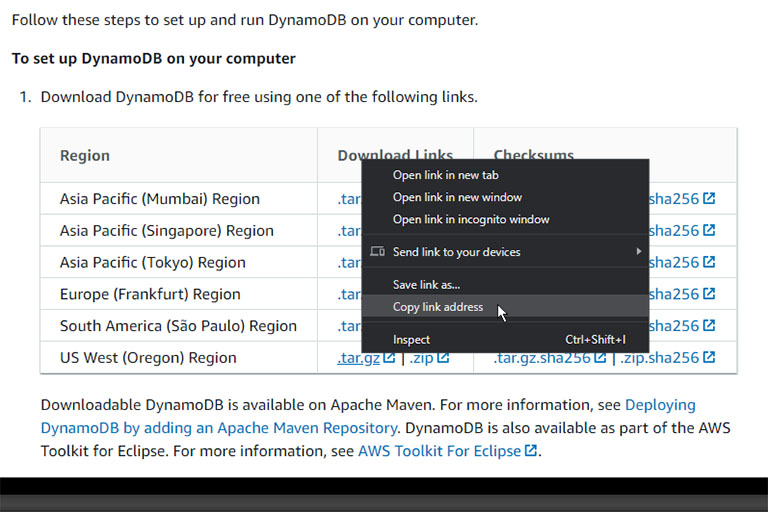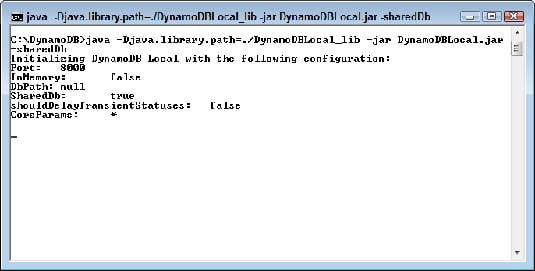

- #DOWNLOAD LOCAL DYNAMODB HOW TO#
- #DOWNLOAD LOCAL DYNAMODB INSTALL#
- #DOWNLOAD LOCAL DYNAMODB CODE#
- #DOWNLOAD LOCAL DYNAMODB TRIAL#
It has a free 7-day trial but requires payment after. It has lots of features and is a popular tool to help manage DyanmoDB databases. Using Dynobaseĭynobase is a GUI client, which helps to explore and interact with DynamoDB easily.
#DOWNLOAD LOCAL DYNAMODB CODE#
The above code adds a new item to WeatherForecast and runs a Scan operation on the table to get back all the data. Var creds = new BasicAWSCredentials ( "fakeMyKeyId", "fakeSecretAccessKey" ) var config = new AmazonDynamoDBConfig ( ) ) var data = await context. The setup is very similar to that of connecting to DynamoDB Web Service, as shown below. Using the AWSSDK.DynamoDBv2 package and the DynamoDbContext class we can connect to the DynamoDB Local instance as well.
#DOWNLOAD LOCAL DYNAMODB HOW TO#
In an earlier post, I had walked through in detail how to get started with DynamoDB from. Similarly, if we use a different Access Key or Region, it will create a new file. If we delete this file, we will lose all data. We can see this file by opening the cli for the Docker instance and listing the files in there (as shown below)Īny actions against this combination of Access Key and Region are stored in this file. Because of this the file created is ’ fakeMyAccessKeyId_ap-southeast-2.db‘. The DynamoDB Local instance creates a unique database file for the AWS Access Key Id and the AWS Region.įor our current set up we have the Access Key id as fakeMyAccessKeyId, and the region is ap-southeast-2. Pass in -region attribute to explicitly specify a region. The above commands uses the default region ( ap-southeast-2), since region is not explicitly specified. The list-tables lists all the tables in the specified local instance.

endpoint-url AWS dynamodb list-tables -endpoint-URL The above command creates ( create-table) a new Table named WeatherForecast with City as the Hash Key and Date the Range Key. provisioned-throughput ReadCapacityUnits = 1,WriteCapacityUnits = 1 ` key-schema AttributeName =City,KeyType =HASH AttributeName =Date,KeyType =RANGE ` attribute-definitions ` AttributeName =City,AttributeType =S ` AttributeName =Date,AttributeType =S ` Run aws configure from the command line and provide fake keys, as shown below. This local version requires any random string as its AWS Access Key ID and Secret Access Key. Once installed, to start accessing the DynamoDB, we need to configure the credentials.
#DOWNLOAD LOCAL DYNAMODB INSTALL#
It makes installing software a breeze, including awscli → choco install awscli If you are on the Windows platform, you can use Chocolatey, which is a Package Manager for Windows. The AWS Command Line Interface, also called AWS CLI is an open-source tool to interact with AWS services from within the command-line shell.Ĭheck out the Installing AWS CLI docs to get it set up on your local machine.

Let’s look at some of the common ways and learn how to access the local DynamoDB instance we just set up.

All ways of accessing the AWS instance also works for the local. The Local DynamoDB is very similar to the instance available in AWS infrastructure. * are configured in the application.The Docker instance is up and running as shown below in the Docker Desktop UI. * Creates a DynamoDB Client provided that DynamoDB properties * Creates the DynamoDB proxy server, client, and tables.ĭynamoDBProxyServer = ServerRunner.createServerFromCommandLineArgs( Lateinit var dynamoDBProxyServer: lateinit var dynamoDBProperties: DynamoDBProperties Lateinit var amazonDynamoDB: AmazonDynamoDB * Usually used as an extension of integration tests. * to be able to test services that depend on it. * This class is to enable a local DynamoDB instance This step is necessary since DynamoDB Local uses SQLite4Java internally. In addition, we need to specify a task (here, `copyNativeDeps`) that copies the native SQLite libraries from the DynamoDB Local dependency to a directory (here, `build/libs`) to be included in the Java library path later. We also need to specify the dependency that we just declared. I used the Frankfurt Region for the release repository but there are other AWS regions available that you can use: id Name "DynamoDB Local Release Repository - EU (Frankfurt) Region"


 0 kommentar(er)
0 kommentar(er)
